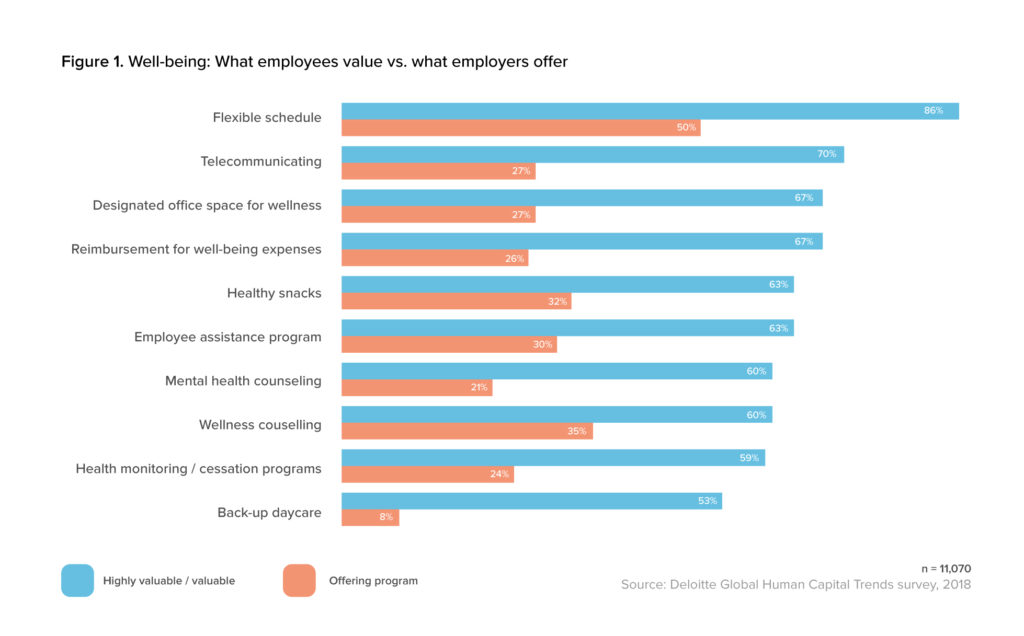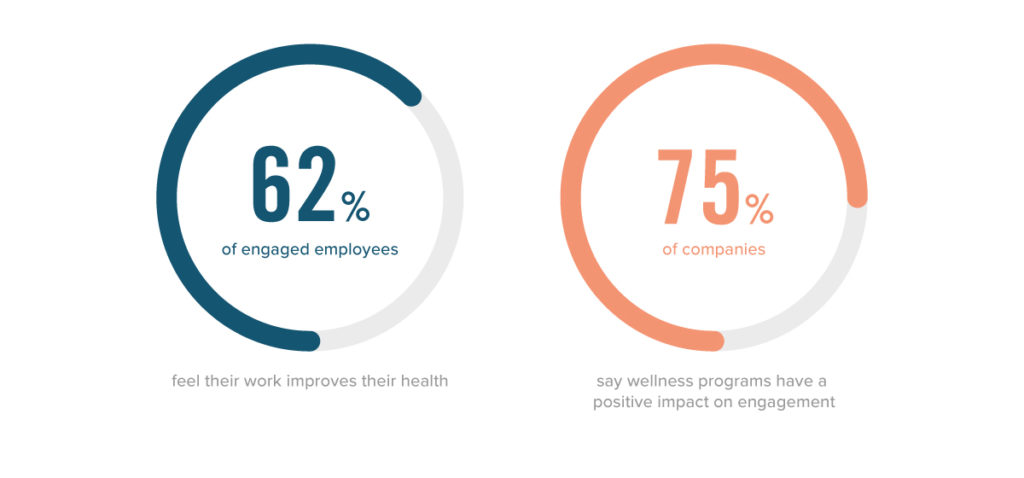Corporate culture is en vogue. Companies make a special effort to document and publish mission statements, determine their core values, and to hire staff with the right “cultural fit.” Health and wellness benefits are a big part of that.
If crafted well, your company culture can impact:
- Productivity and commitment to excellent;
- Staff retention rates; and
- Your public image and identity
And it can even boost sales. Customers want to know that you take care of your staff. Prove that you do, and buyers will be proud to purchase your goods or services. A good employee health and wellness program can become central to your identity – a way to show that your company cares. Revenue is just one of many clear benefits to a good well-being program. We’ve found seven more that should get you excited.
7 ways that health and wellness benefits improve company culture
Lots of factors impact your culture. Working conditions, interpersonal relationships, and management styles are all hugely important. And of course, the health and happiness of your team is too. Here are the impacts that health and wellness programs can have on a company’s culture:
1. Build unity and team spirit
It seems obvious, but a united and committed workforce is crucial to your culture. When everyone works together, the company becomes about more than just numbers and a payslip. Team members want to work for each other. And of course, sports are a great way to build that team spirit. Especially team sports.

An example of this in practice is communications tech business Bandwidth. The company is known for offering a 90-minute “fitness lunch*¹” to everyone who wants it. That is, you can take 90 minutes for your lunch break, provided you do something active. So that’s already a good excuse to workout together. But Bandwidth also holds monthly company-wide fitness challenges, sponsors office sports teams, and plays daily basketball or ultimate frisbee games.
The goal of these initiatives is not only to have active employees, but for them to enjoy these activities together. In the words of one Bandwidth employee*²: “It’s pretty amazing to work at a company that is so genuine at helping people in both their work and personal lives – and doesn’t just go through the motions.”
2. Maintain a healthy workforce
Improved employee health comes with a few direct benefits. Chief among them is the need for fewer sick days and reduced health costs for companies who provide cover. But there’s a psychological benefit to making health a priority. If people associate the office with stress and tiredness, that becomes part of the company culture.

If instead they associate work with fun activities and health initiatives, then that’s what your culture will be built on. So companies need to find ways to encourage healthy habits among employees. This can mean increased physical activity, or massage and meditation in order to limit stress.
Activity tracker Fitbit uses its own technology*³ to help its team be more active. Employees wear Fitbits to work, and the most active team members are eligible for prizes. As long as these kinds of initiatives are inclusive and don’t just favour the super-fit, they can be a fun way to bring out the competitive spirit in everyone.
3. Enhance your employer brand
There’s more competition for talent than ever before. Companies are desperate to find good people, and know they need to provide an exceptional workplace to do this. That can mean massages, nap rooms, and table tennis. It can also mean remote work and teleconferencing.
If you want the best talent, you have to provide the right environment. And if you want to keep that talent, they need to feel connected to the company culture. This means creating an environment that suits workers – not just finding workers to suit the environment. But as you can see, there’s still a disconnect between what employees think is important, and what their companies actually provide:

Each additional benefit you can offer becomes a competitive advantage. To secure the best candidates (and keep them around), you need to show that you’re invested in them. When companies take health and wellness seriously, this creates a culture in which team members feel valued and empowered to achieve their best.
4. Increase employee engagement
“Engagement” is a popular concept among business leaders. Every CEO and HR manager wants to ensure that their team participates and commits fully to the company’s vision. And with good reason.
Engaged employees*⁴ are more motivated, more productive, and show a greater commitment to excellence. So whatever you can do to foster engagement, you must. Thankfully, physical health and engagement go hand in hand. 62% of engaged employees*⁵ feel their work improves their health. Meanwhile one survey found that 75% of companies*⁶ say wellness programs have a positive impact on engagement.

A study by The Economist*⁷ found that “a wellness culture magnifies the benefits that employees gain from their participation while driving increased engagement, especially if they offer a wide range of choices.” That “wide range of choices” is crucial to a good wellness program. Rather than dictating how team members should make themselves healthier and more active, it’s best to give options that suit everyone.
For example, Expedia UK*⁸ gives employees between £400-1,000 as a “wellness allowance.” In practice, they can use this for any wellness-increasing expense: shoes, or a gym membership, for example – within some limits. The beauty of this program is that employees get to choose for themselves. The company promotes its culture of wellness, but by giving team members the freedom to express this however they wish.
5. Reduce employee turnover
The other major benefit of increased engagement is that it’s one of the best ways to keep your team around for longer. When employees are less committed to the cause, they’re far more likely to look for greener pastures. Health and wellness programs improve engagement, as we’ve seen. They’re also recommended*⁹ as a way to keep employee churn to a minimum.
When team members feel that their health and well-being is a priority for management, they’re more likely to stick around. And clearly it works. 60% of employers*¹⁰ report that wellness programs have improved employee retention.
Something as simple as giving exercise and relaxation options to your team can be the difference between constant churn and a workforce that sticks around for the long haul.
6. Get better creative output
Physical health and well-being are inextricably linked with strong creative yield. A 15-country study*¹¹ (with nearly 29,000 participants) found that companies which promote health and wellness are also more likely to encourage creativity and innovation.
And forward-thinking businesses are reaping the benefits. Companies with health programs don’t just have healthier employers – although that’s certainly the case. They actually see more creativity, too. “Fitness helps us keep sharp. People are happier, creating better products, living better lives,” says Mobify’s CEO Igor Faletski*¹². The Canadian tech company offers a range of ways for team members to de-stress physically and mentally:

Employees once even learned how to play Quidditch*¹³ – the magical sport from Harry Potter.
The ultimate goal is to relax as a team and think about something other than work. This makes employees more productive – and more creative – when it’s time to focus.
7. Improve job satisfaction
Employers should definitely be worried about staff happiness. Here are a couple of potentially alarming facts about employee satisfaction:
- Only 65% of German workers*¹⁴ are happy in their jobs
- 56% of British workers*¹⁵ are unhappy in their jobs
Why does this matter? Because more and more, workers are choosing happiness*¹⁶ over higher pay. You may not be able to woo the next hot candidate with salary alone.
And of course, happier employees stick around longer, too. Plus, shouldn’t you want your team to feel satisfied with their work? Isn’t that one of the best parts of running a business – having a happy and fulfilled team?
Online retailer Zappos is famous for its culture. Any time you read about the company, it’s a positive story about how it keeps employees happy. Job satisfaction levels*¹⁷ at Zappos are legendary. Part of this is a focus on wellness in a way that suits individuals. Wellness coordinator Kelly Maher*¹⁸ explains “our programs get people to realize that stereotypical exercise isn’t the only way to be well and be happy. It’s about getting people to want to do things voluntarily, not forcing them.”
Maher makes sure that health initiatives are always changing, and that employees with different passions and levels of fitness will always have something to make them happy at work. Once again, it’s about associating work with a positive, healthy culture. And while that doesn’t always mean gym workouts and team sports, being active is so important.
Make health and wellness benefits a cultural touchstone
Modern companies choose many factors to be central their corporate culture. Popular choices include customer-centricity, innovation and the right to fail, radical honesty, and financial transparency. We believe employee health and happiness should be first on every list. The evidence is clear, and the benefits are too many to count.
We’ve looked at seven good reasons in this post, and we could easily give dozens more. Employee well-being can truly be the foundation for an exceptional corporate culture. After all, without employees you have no culture at all.
WOULD YOU LIKE TO KNOW MORE ABOUT OUR CORPORATE FITNESS OFFERS?
[contact-form-7 id=”2197″ title=”Contact form”]

References:
*¹ https://www.bandwidth.com/blog/how-i-lunch/
*² https://www.bandwidth.com/blog/how-i-lunch/
*³ https://risepeople.com/blog/10-companies-with-amazing-workplace-wellness-programs/
*⁴ http://hrexecutive.com/engagement-through-wellness/
*⁵ https://www.forbes.com/sites/alankohll/2018/07/30/your-employee-engagement-strategy-needs-more-wellness/#1559484e42b5
*⁶ https://community.virginpulse.com/2017-business-of-healthy-employees?utm_campaign=CAM-09-Biz-of-Healthy-EEs&utm_source=press-release
*⁷ https://eiuperspectives.economist.com/sites/default/files/EIU_Humana_Wellness_fin_0.pdf
*⁸ https://www.digitalhrtech.com/best-employee-wellness-programs-examples/
*⁹ https://www.bmmagazine.co.uk/business/how-to-reduce-staff-turnover-by-prioritising-wellbeing/
*¹⁰ https://www2.deloitte.com/insights/us/en/focus/human-capital-trends/2018/employee-well-being-programs.html
*¹¹ https://www.shrm.org/resourcesandtools/hr-topics/benefits/pages/wellbeinginnovation.aspx
*¹² https://www.freshgigs.ca/blog/creative-cultures-mobify-makes-work-fun/
*¹³ https://www.freshgigs.ca/blog/creative-cultures-mobify-makes-work-fun/
*¹⁴ https://www.euractiv.com/section/economy-jobs/news/employees-are-particularly-unhappy-in-germany/
*¹⁵ https://www.menshealth.com/uk/mental-strength/a25884510/workplace-wellness/
*¹⁶ https://workplaceinsight.net/over-50-percent-of-uk-employees-choose-job-happiness-over-pay-cheque-size/
*¹⁷ https://www.geteverwise.com/leadership/how-tony-hsieh-and-zappos-are-shaping-the-future-of-employee-satisfaction/
*¹⁸ https://mashable.com/2015/05/15/unique-corporate-wellness-programs/?europe=true

